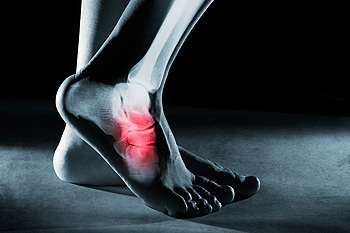Items filtered by date: October 2022
Nerve Damage to the Feet Caused by Diabetes

The nerves of the body send signals to its parts in the periphery, such as the feet. A diabetic who has developed nerve damage from long-term high blood sugar levels may have a side effect known as neuropathy. This results in a lack of feeling in the feet, which may cause other harmful side effects. Some risk factors that can cause neuropathy include overconsumption of alcohol, imbalance in vitamin B levels, and certain medications. Among the symptoms of diabetic nerve damage are prickling, tingling, and burning sensations. In addition, someone with diabetic neuropathy may experience sharp, shooting pain that feels like being pricked by a needle. If you have nerve damage in your feet, you may also be at risk of developing ulcers from sores, cuts, or wounds that go undetected due to numbness. Although there is no cure yet for diabetic neuropathy, several treatments are available to reduce its effects. For additional help, please consult with a podiatrist who is trained in how to handle this type of condition.
Neuropathy
Neuropathy can be a potentially serious condition, especially if it is left undiagnosed. If you have any concerns that you may be experiencing nerve loss in your feet, consult with Gregory Rorick, DPM from Rorick Podiatry, PC. Our doctor will assess your condition and provide you with quality foot and ankle treatment for neuropathy.
What Is Neuropathy?
Neuropathy is a condition that leads to damage to the nerves in the body. Peripheral neuropathy, or neuropathy that affects your peripheral nervous system, usually occurs in the feet. Neuropathy can be triggered by a number of different causes. Such causes include diabetes, infections, cancers, disorders, and toxic substances.
Symptoms of Neuropathy Include:
- Numbness
- Sensation loss
- Prickling and tingling sensations
- Throbbing, freezing, burning pains
- Muscle weakness
Those with diabetes are at serious risk due to being unable to feel an ulcer on their feet. Diabetics usually also suffer from poor blood circulation. This can lead to the wound not healing, infections occurring, and the limb may have to be amputated.
Treatment
To treat neuropathy in the foot, podiatrists will first diagnose the cause of the neuropathy. Figuring out the underlying cause of the neuropathy will allow the podiatrist to prescribe the best treatment, whether it be caused by diabetes, toxic substance exposure, infection, etc. If the nerve has not died, then it’s possible that sensation may be able to return to the foot.
Pain medication may be issued for pain. Electrical nerve stimulation can be used to stimulate nerves. If the neuropathy is caused from pressure on the nerves, then surgery may be necessary.
If you have any questions, please feel free to contact our office located in New York Mills, Utica, NY . We offer the newest diagnostic and treatment technologies for all your foot care needs.
Don't Ignore a Stress Fracture

A stress fracture happens as a result of repetitive use of the feet and can occur from excessive running, walking, or participating in jumping activities. Pain and discomfort often accompany a stress fracture and it can be common for it to be ignored. Many people feel uncomfortable giving up exercising because of a stress fracture, despite knowing that this is temporarily the best thing that can be done to ensure proper healing. There are alternatives to exercises that many people have found to be enjoyable, in addition to maintaining cardiovascular health. These include swimming, cycling, and water aerobics. Additionally, patients can opt to use a stationary bike that has no impact on the feet. It is beneficial to treat a stress fracture by frequently elevating the affected foot and wearing a protective boot can provide adequate stability as well. If you have developed a stress fracture in your foot, please contact a podiatrist for effective relief methods.
Activities where too much pressure is put on the feet can cause stress fractures. To learn more, contact Gregory Rorick, DPM from Rorick Podiatry, PC. Our doctor can provide the care you need to keep your pain free and on your feet.
Dealing with Stress Fractures of the Foot and Ankle
Stress fractures occur in the foot and ankle when muscles in these areas weaken from too much or too little use. The feet and ankles then lose support when walking or running from the impact of the ground. Since there is no protection, the bones receive the full impact of each step. Stress on the feet can cause cracks to form in the bones, thus creating stress fractures.
What Are Stress Fractures?
Stress fractures occur frequently in individuals whose daily activities cause great impact on the feet and ankles. Stress factors are most common among:
- Runners
- People affected with Osteoporosis
- Tennis or basketball players
- Gymnasts
- High impact workouts
Symptoms
Pain from the fractures occur in the area of the fractures and can be constant or intermittent. It will often cause sharp or dull pain with swelling and tenderness. Engaging in any kind of activity which involves high impact will aggravate pain.
If you have any questions please feel free to contact our office located in New York Mills, Utica, NY . We offer the newest diagnostic and treatment technologies for all your foot and ankle needs.
Can Heel Pain Be Reduced?

There are numerous reasons that people may experience heel pain. Plantar fasciitis, one of the most common forms of heel pain, may need prompt treatment to diminish existing pain. An injury that happens to the Achilles tendon often results in heel pain, and medical conditions such as arthritis and thyroid disorders may contribute to heel pain. Many patients can find mild relief by practicing specific stretches that can strengthen the heel. These can include standing on a step, and gently lowering the heels one at a time until a gentle stretch is felt. When the foot is rolled on a foam roller or a tennis ball, this may be effective in stretching the muscles on the bottom of the foot. Heel pain may be avoided by wearing shoes that fit correctly, and have adequate arch support. Practicing low-impact activities consisting of swimming and cycling may also be beneficial in replacing running and jumping exercises. If you have heel pain for any reason, please schedule an appointment with a podiatrist as quickly as possible who can determine the cause and provide effective treatment options.
Many people suffer from bouts of heel pain. For more information, contact Gregory Rorick, DPM of Rorick Podiatry, PC. Our doctor can provide the care you need to keep you pain-free and on your feet.
Causes of Heel Pain
Heel pain is often associated with plantar fasciitis. The plantar fascia is a band of tissues that extends along the bottom of the foot. A rip or tear in this ligament can cause inflammation of the tissue.
Achilles tendonitis is another cause of heel pain. Inflammation of the Achilles tendon will cause pain from fractures and muscle tearing. Lack of flexibility is also another symptom.
Heel spurs are another cause of pain. When the tissues of the plantar fascia undergo a great deal of stress, it can lead to ligament separation from the heel bone, causing heel spurs.
Why Might Heel Pain Occur?
- Wearing ill-fitting shoes
- Wearing non-supportive shoes
- Weight change
- Excessive running
Treatments
Heel pain should be treated as soon as possible for immediate results. Keeping your feet in a stress-free environment will help. If you suffer from Achilles tendonitis or plantar fasciitis, applying ice will reduce the swelling. Stretching before an exercise like running will help the muscles. Using all these tips will help make heel pain a condition of the past.
If you have any questions please contact our office located in New York Mills, Utica, NY . We offer the newest diagnostic and treatment technologies for all your foot and ankle needs.
Are Bunions Affecting Your Everyday Life?
Plantar Fasciitis May Develop From Several Reasons

When the plantar fascia becomes inflamed, it may be indicative of a foot condition referred to as plantar fasciitis. Research has shown plantar fasciitis affects approximately 10% of the population worldwide, and often causes severe heel pain. The plantar fascia, found on the sole of the foot, is a band of tissue that connects the heel to the toes. Excessive running or wearing shoes that do not fit correctly may cause the plantar fascia to become inflamed. Additionally, plantar fasciitis may develop from standing on hard surfaces for most of the day, or if the tissue becomes overstretched. Relief may be found when specific stretches are performed and shoes that are worn that have adequate cushioning. In severe cases, surgery may be necessary to permanently repair the plantar fascia. In patients who are overweight, it is suggested that eating healthy foods can help to reduce the effect body’s weight has on the soles of the feet. If you have heel pain, it is strongly suggested that you schedule an appointment with a podiatrist as quickly as possible who can diagnose and treat plantar fasciitis.
Plantar fasciitis is a common foot condition that is often caused by a strain injury. If you are experiencing heel pain or symptoms of plantar fasciitis, contact Gregory Rorick, DPM from Rorick Podiatry, PC. Our doctor can provide the care you need to keep you pain-free and on your feet.
What Is Plantar Fasciitis?
Plantar fasciitis is one of the most common causes of heel pain. The plantar fascia is a ligament that connects your heel to the front of your foot. When this ligament becomes inflamed, plantar fasciitis is the result. If you have plantar fasciitis you will have a stabbing pain that usually occurs with your first steps in the morning. As the day progresses and you walk around more, this pain will start to disappear, but it will return after long periods of standing or sitting.
What Causes Plantar Fasciitis?
- Excessive running
- Having high arches in your feet
- Other foot issues such as flat feet
- Pregnancy (due to the sudden weight gain)
- Being on your feet very often
There are some risk factors that may make you more likely to develop plantar fasciitis compared to others. The condition most commonly affects adults between the ages of 40 and 60. It also tends to affect people who are obese because the extra pounds result in extra stress being placed on the plantar fascia.
Prevention
- Take good care of your feet – Wear shoes that have good arch support and heel cushioning.
- Maintain a healthy weight
- If you are a runner, alternate running with other sports that won’t cause heel pain
There are a variety of treatment options available for plantar fasciitis along with the pain that accompanies it. Additionally, physical therapy is a very important component in the treatment process. It is important that you meet with your podiatrist to determine which treatment option is best for you.
If you have any questions, please feel free to contact our office located in New York Mills, Utica, NY . We offer the newest diagnostic and treatment technologies for all your foot care needs.

